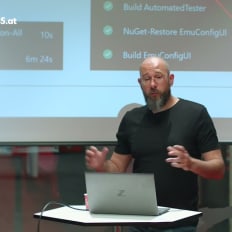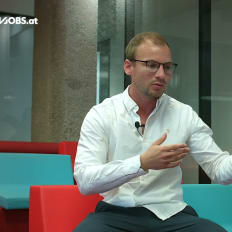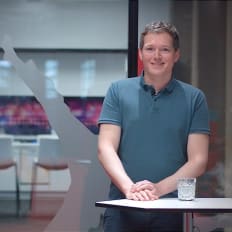
TGW Logistics Group
Sascha Beyer, Full Stack Developer bei TGW Logistics Group
Description
Sascha Beyer von der TGW Logistics Group berichtet im Interview über seinen Werdegang, was er im Unternehmen als Full Stack Developer macht und gibt Tipps für Anfänger.
By playing the video, you agree to data transfer to YouTube and acknowledge the privacy policy.
Video Summary
In “Sascha Beyer, Full Stack Developer bei TGW Logistics Group,” Sascha Beyer traces his journey from early enthusiasm for electronics and BASIC, through teenage Java and a mechatronics apprenticeship, to a Software Engineering degree and a shift from control systems to C#, .NET, and IoT. At TGW, he has spent about two years on a greenfield effort: a cloud IoT platform for data capture, analysis, machine learning, and visualization built with modern technologies. His advice stresses intrinsic motivation, learning and tinkering in your free time, creative problem-solving on the backend, and the willingness to handle less glamorous tasks and iteratively improve solutions.
From Mechatronics to Full‑Stack: How Sascha Beyer at TGW Logistics Group Builds a Greenfield Cloud IoT Platform with C#/.NET and Machine Learning
A simple story that explains a lot
“Eigentlich ist das eine ganz einfache Geschichte.” With that understated line, the session titled “Sascha Beyer, Full Stack Developer bei TGW Logistics Group” (Speaker: Sascha Beyer, Company: TGW Logistics Group) opens a window into a developer journey powered by curiosity and persistence. As a child, Beyer received a computer from his uncle—not just to play, but to learn BASIC on clunky floppy disks. The mix of tinkering and gameplay wasn’t a detour; it was the ignition.
“Damals im Kindesalter habe ich von meinem Onkel einen Computer geschenkt bekommen, zum Basic-Programmieren. Da waren noch so fette floppy disks.”
From our DevJobs.at editorial lens, that’s the pattern we see again and again: early exposure that normalizes technology, makes experimentation feel natural, and turns fascination into a habit.
Java at 16–17: turning curiosity into output
The teenage phase follows: at 16–17, Beyer writes simple Java programs. No elaborate setup, just starting and learning by doing. It’s a small step in form, but a huge one in trajectory: building something changes how you think about what’s possible.
“Irgendwann, mit 16, 17, ist das Ganze dann mit Java weitergegangen. Da habe ich dann einfachste Java-Programme geschrieben.”
Once you’ve written code that runs, the internal question shifts from “if” to “how.” That mental shift is often a stronger predictor of engineering growth than credentials.
Apprenticeship in mechatronics: hardware sense meets software ambition
Beyer’s first professional milestone is an apprenticeship as a mechatronics technician. That may sound like a detour if you’re focused on software, but in practice it becomes a powerful layer in his later full‑stack profile: systems thinking, respect for physical constraints, and a pragmatic bias for reliable engineering.
“Mein Lehr habe ich aber als Mechatroniker gemacht.”
It’s not an either/or. The hands-on perspective from mechatronics later grounds software decisions. When you’ve worked with real systems, you carry a healthy instinct for robustness and clarity into your code.
Back to school: studying Software Engineering
In his mid‑twenties, Beyer decides to study Software Engineering. That’s the formal pivot from control engineering to software as the main arena.
“Später, Mitte 20, habe ich mich dann entschlossen, dass ich noch studiere. Ich habe Software-Engineering studiert und habe dann tatsächlich im richtigen Software-Bereich zum Entwickeln angefangen.”
The emphasis on “tatsächlich” (actually) marks the shift from steering hardware to designing software solutions. It’s a move many engineers will recognize: stepping from the concrete into the abstract, from local control logic into a broader software landscape.
From control engineering to software development
Before software, there was Steuerungsentwicklung—control engineering. Beyer honors that phase as “spannend” and “eine coole Sache,” while being clear about his forward motion into software development.
“Vorher habe ich nur Steuerungsentwicklung gemacht, auch spannend. Definitiv eine coole Sache. Aber ich habe mich halt einfach mehr in die tatsächliche Software-Errichtung gedreht.”
This shift is technical and cultural: more abstraction, more architecture, a faster learning cadence than hardware cycles. It’s where a full‑stack identity begins to crystallize.
Today’s stack: C#, .NET, and the IoT mindset
Beyer positions his current focus succinctly: C#, .NET, and “everything to do with IoT.” It’s the toolset that aligns with the platform his team is building.
“Mittlerweile mehr C-Sharp, .NET, neuere Technologien im Sinne von alles, was mit IoT zu tun hat.”
Read that as a trajectory: sensors and data; connectivity and processing; and, ultimately, visualization—an end‑to‑end view where information moves from capture to insight.
A greenfield at TGW Logistics Group: a cloud platform for data capture, analysis, ML, and visualization
A little over two years ago, Beyer joined his current team. Since then, it’s been a greenfield journey. TGW Logistics Group decided to build a cloud platform—a modern IoT platform that records data, analyzes it, processes it with machine learning, and visualizes it. Not a single component, but a complete platform, “all in the cloud.”
“Wir machen ein Produkt auf grüner Wiese, also wirklich ganz was Neues. Die DGW hat entschieden, dass wir eine Cloud-Plattform bauen für Datenerfassung, moderne Sprache, IoT-Plattform. Wir zeichnen Daten auf, analysieren die, verarbeiten mit Machine Learning und alles drum und dran und dann anzeigen, visualisieren … da gehört halt einfach komplette Plattform dazu.”
Beyer even frames it, with a touch of humor, as: “We’re building a chatting platform.” It reads like a metaphor for systems that converse, for components that exchange signals and state, for data flows that coordinate.
“Letzten Endes, was würde man sagen? Wir entwickeln eine Chatting-Plattform.”
What matters is the posture: a greenfield cloud platform forces deliberate choices. Inputs, transformation, service interaction, visualization—end‑to‑end thinking rather than feature accumulation. That’s exactly what we hear in his remarks.
Modern technologies, new challenges—and very few ready-made answers
Beyer characterizes the work as “modernste Technologien, alles in der Cloud”—and immediately nails the rub: “permanent neue Herausforderungen.” When few teams have done similar things before, “Leichtlösungen” (easy answers) are rare. That’s when thinking becomes the primary tool.
“Absolut spannend, modernste Technologien, alles in der Cloud. Eigentlich genau das, was man sich von der heutigen Softwareentwicklung wünscht. Und permanent neue Herausforderungen, weil Dinge, die wir da entwickeln, haben wenig andere vorher gemacht und dementsprechend fehlen … Leichtlösungen. Man muss schon selbst seinen Kopf aktivieren …”
This is the essence of greenfield engineering: derive solutions from principles, not templates. Best practices help, but they don’t substitute for deliberate problem framing when the terrain is new.
Intrinsic motivation first: “Bring high self‑interest”
When offering advice, Beyer starts from within. If you love programming, if you dig into technology in your free time, you’re equipped for this kind of work. Layer patterns on top of that, and you multiply your growth.
“Ich würde sagen, man sollte auf alle Fälle hohes Eigeninteresse mitbringen. … du programmierst eigentlich komplett gern … in deiner Freizeit setzt dich mit Technologien auseinander … Und wenn du dann nur dazu patternst … und … lernst, in deiner Freizeit, noch besser.”
In a context with few ready‑made answers, self‑drive is the critical resource. Learning routines and deliberate practice are not vanity—they’re what keeps you nimble in unfamiliar problem spaces.
Backend is creative work—just a different kind of creativity
Beyer makes a point we appreciate: creativity isn’t confined to user interfaces. Backend work requires creativity too—just expressed differently. It’s about structure, decomposition, and finding workable paths where none are obvious.
“Was für das Backend definitiv wichtig ist … dass man Sachen lösen kann … so wie es beim UI auch ist, kreativ ist … nur eine andere Kreativität …”
That “other creativity” often comes in two moves: invention and reduction. Crafting a new route—or boldly removing what makes the path overly complex. In backend architecture, choosing the right abstraction at the right time is a creative act.
Solve first, beautify later: a pragmatic rule of thumb
A recurring theme in Beyer’s remarks is pragmatism. Sometimes the first cut isn’t pretty. That’s okay—if it yields a solution. Refinement can follow. The crucial part is the will to produce a workable outcome.
“… bereit sein, dass man … mal vielleicht was nicht so Schönes macht … auf eine Lösung kommt … die kann man dann schöner machen, aber man muss halt lösungswillig sein.”
As a working rule: function before elegance, outcome before aesthetics—provided the team follows up with improvement and refactoring. This keeps projects moving and reduces paralysis by perfection.
Two years in: enough time for platform identity to form
“Vor gut zwei Jahren angefangen”—that’s long enough for foundational choices to be made and for a shared vocabulary to emerge: what “done” means, what quality looks like, how results become visible. Even without implementation details, Beyer’s description makes it clear: a platform is being built, not just a stack of features.
“Wir machen ein Produkt auf grüner Wiese … komplette Plattform … alles in der Cloud.”
Greenfield teams often coalesce around habits and principles more than tools. That continuity—curiosity, solution focus, learning—is what keeps the system evolving.
The toolbelt implied by the story
Without invoking buzzwords, Beyer’s remarks point to a handful of practical concerns that define work on a cloud/IoT platform. These aren’t claims about his implementation—just faithful readings of what such a platform entails when you say “record, analyze, ML, visualize” in the cloud:
- Treat data capture as a first‑class problem: if you “record data,” quality and context are non‑negotiable.
- Analyze with hypotheses: not every metric explains something useful; start with questions.
- Use ML as part of a pipeline, not an ornament: “process with Machine Learning” works best when the end‑to‑end path is clear.
- Visualize to enable decisions: “visualize” should serve understanding and action, not just aesthetics.
- Cloud as enabler and responsibility: “all in the cloud” expands options—and demands clear choices.
Again, these are editorial reflections mapped to Beyer’s framing: an end‑to‑end platform, cloud‑first, with data flowing to insight.
Condensed advice for backend and full‑stack developers
Beyer’s guidance distills into five short principles:
- Nurture intrinsic motivation: if you “completely enjoy” programming, you’ll learn faster and deeper.
- Study patterns: they give you language and structure for recurring problems.
- Be creative beyond the UI: backend creativity is about problem framing and right‑sized abstractions.
- Solve now, polish later: get to a working solution; refactor after.
- Think for yourself: when there are “no easy answers,” thinking beats searching.
These principles fit the kind of work Beyer describes—and generalize well to other engineering contexts.
What we took from “Sascha Beyer, Full Stack Developer bei TGW Logistics Group”
This devstory isn’t about glossy slides—it’s about a grounded path into impactful software work:
- Early curiosity that made technology feel accessible.
- A mechatronics apprenticeship that built systems instincts.
- A decisive move into software via a Software Engineering degree.
- A team building a greenfield cloud IoT platform that records, analyzes, applies ML, and visualizes data.
- A mindset that values solutions over dogma and learning over prestige.
Summed up: choose work that challenges you, not work that flatters you. Then “modern technologies, all in the cloud” stops being buzzwords and becomes a canvas for real engineering.
Quotes worth keeping
A handful of lines from the talk we’d pin above the desk:
“Man muss schon selbst seinen Kopf aktivieren.”
“Hohes Eigeninteresse … in deiner Freizeit setzt dich mit Technologien auseinander …”
“Mal … was nicht so Schönes … Lösung … später schöner machen …”
“Produkt auf grüner Wiese … komplette Plattform … alles in der Cloud.”
“Wir entwickeln eine Chatting‑Plattform.”
Closing: a simple story—precisely the good kind
Beyer tells his path without embellishment: a childhood computer for BASIC and games; simple Java programs at 16–17; a mechatronics apprenticeship; a Software Engineering degree; a move from control engineering into software; a focus on C#/.NET and IoT; and today, a greenfield platform at TGW Logistics Group that records, analyzes, processes with Machine Learning, and visualizes—“all in the cloud.”
For anyone entering software or recalibrating their path, those are clear coordinates: curiosity before credentials, learning before perfection, solutions before elegance. That’s the soil where good platforms grow—and the teams that build them.
More Tech Talks
More Tech Lead Stories
TGW Logistics Group Klausmair Philipp, Head of Global Controls Tool Development bei TGW Logistics Group
Head of Global Controls Tool Development bei der TGW Logistics Group Philipp Klausmair erzählt im Interview über das vergleichsweise neue Team im Unternehmen, wie dort das Recruiting abläuft und gibt Einblick in die verwendeten Technologien.
Watch nowTGW Logistics Group Mario Leitner, Head of Software Development bei TGW Logistics Group
Head of Software Development Intelligent Automation bei der TGW Logistics Group Mario Leitner spricht im Interview über den Aufbau der Devteams im Unternehmen, was Neuankömmlinge erwartet und welche Technologien verwendet werden.
Watch now





